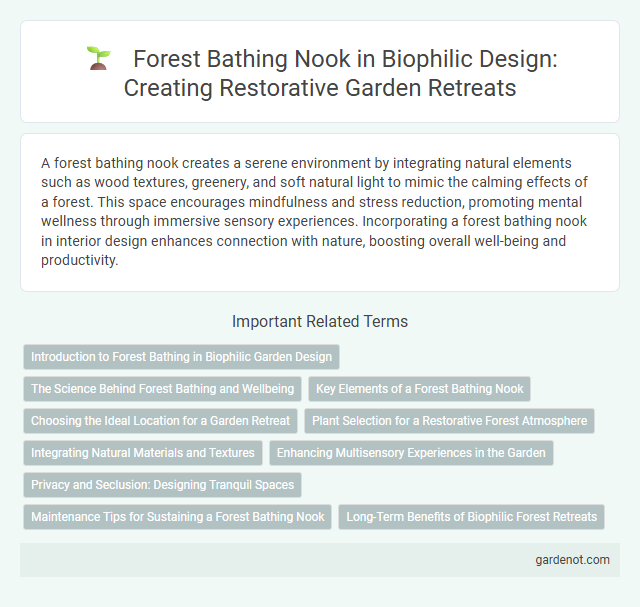A forest bathing nook creates a serene environment by integrating natural elements such as wood textures, greenery, and soft natural light to mimic the calming effects of a forest. This space encourages mindfulness and stress reduction, promoting mental wellness through immersive sensory experiences. Incorporating a forest bathing nook in interior design enhances connection with nature, boosting overall well-being and productivity.
Introduction to Forest Bathing in Biophilic Garden Design
Forest bathing, originating from the Japanese practice of Shinrin-yoku, involves immersing oneself in a natural forest environment to promote mental and physical well-being. In biophilic garden design, incorporating a dedicated forest bathing nook uses elements such as native trees, shrubs, and natural materials to create a serene space that enhances relaxation and reduces stress. This design approach emphasizes sensory engagement with nature, fostering a deeper connection to the environment and supporting holistic health benefits.
The Science Behind Forest Bathing and Wellbeing
Forest bathing, or shinrin-yoku, involves immersing oneself in natural forest environments to stimulate the senses and promote mental and physical health. Scientific studies demonstrate that exposure to forest settings lowers cortisol levels, reduces blood pressure, and enhances immune function through increased natural killer cell activity. Incorporating a forest bathing nook in biophilic design leverages these physiological benefits to create restorative spaces that foster wellbeing and stress reduction.
Key Elements of a Forest Bathing Nook
A forest bathing nook integrates natural elements such as live plants, textured wood, and soft, ambient lighting to mimic a serene woodland environment, promoting relaxation and mindfulness. Incorporating natural sounds like bird songs or rustling leaves enhances sensory immersion, while ergonomic seating crafted from sustainable materials ensures comfort during extended use. This space prioritizes connection with nature, improving mental well-being through carefully curated biophilic features that stimulate the senses and reduce stress.
Choosing the Ideal Location for a Garden Retreat
Selecting the ideal location for a forest bathing nook involves prioritizing quiet, secluded areas rich in native vegetation to maximize sensory immersion. Proximity to natural elements like flowing water, diverse plant life, and ample shade enhances the restorative benefits by promoting relaxation and reducing stress. Incorporating natural topography such as gentle slopes or sheltered hollows further deepens the connection to nature, supporting a truly transformative garden retreat experience.
Plant Selection for a Restorative Forest Atmosphere
Selecting shade-tolerant plants such as ferns, mosses, and evergreen shrubs enhances a forest bathing nook's restorative ambiance by mimicking natural woodland understories. Incorporating native species like Douglas fir, western hemlock, and salal supports local ecosystems and promotes mental well-being through biophilic connection. Layering diverse plant textures and heights creates a tranquil, immersive environment that encourages relaxation and stress reduction.
Integrating Natural Materials and Textures
Incorporating natural materials such as reclaimed wood, bamboo, and stone creates a tactile connection to the forest environment within a forest bathing nook. Textures like woven rattan, moss cushions, and bark-inspired wall coverings enhance sensory engagement and promote relaxation. These organic elements not only evoke the serenity of woodland settings but also improve air quality and overall well-being through biophilic design principles.
Enhancing Multisensory Experiences in the Garden
Forest bathing nooks integrate natural elements such as textured wood, aromatic plants, and flowing water features to enhance multisensory engagement in garden spaces. These immersive environments stimulate sight, sound, smell, touch, and even taste, fostering relaxation and reducing stress by reconnecting individuals with nature. Incorporating diverse flora and natural materials amplifies sensory depth, promoting wellbeing through experiential biophilic design.
Privacy and Seclusion: Designing Tranquil Spaces
A forest bathing nook offers a carefully designed retreat that emphasizes privacy and seclusion, allowing individuals to fully immerse in nature's calming elements. Incorporating dense foliage, natural barriers, and sound-absorbing materials enhances acoustic privacy and visual isolation, fostering deep relaxation. This immersive, tranquil space supports mental restoration by minimizing external distractions and promoting a profound connection with the natural environment.
Maintenance Tips for Sustaining a Forest Bathing Nook
Maintaining a forest bathing nook requires regular pruning to encourage healthy plant growth and prevent overcrowding, ensuring air circulation mimics a natural forest environment. Incorporating organic mulch helps retain soil moisture and suppress weed growth, supporting the nook's ecosystem. Periodic monitoring for pests and diseases allows for early intervention with eco-friendly treatments, sustaining the nook's tranquility and promoting wellness benefits.
Long-Term Benefits of Biophilic Forest Retreats
Biophilic forest retreats, such as forest bathing nooks, promote long-term mental health by reducing stress, enhancing mood, and improving cognitive function through sustained exposure to natural environments. These retreats support immune system resilience and cardiovascular health by encouraging regular immersion in phytoncides and fresh air, which boost physiological well-being. Incorporating biophilic design elements fosters lasting connections with nature, leading to improved creativity, productivity, and overall quality of life.
Forest bathing nook Infographic

 gardenot.com
gardenot.com